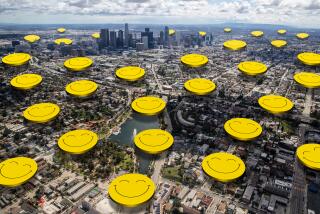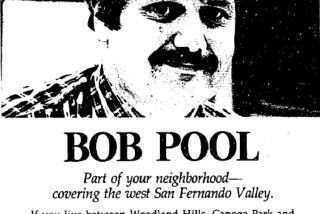* Bob Hebert; Sportswriter and Horse Race Handicapper
- Share via
Bob Hebert, 90, a retired Los Angeles Times sportswriter who for many years was one of the nation’s leading turf writers and racing handicappers. In addition to his work for The Times, its now defunct sister publication, the Los Angeles Mirror, and the old Los Angeles Daily News, Hebert was a regular contributor to the racing publication the Blood Horse, and wrote a popular book on how to handicap the horses. Born Clarence S. Hebert Jr. in New Orleans in 1909, he attended public schools and Loyola University there before moving to Los Angeles in the 1930s. His first newspaper writing job was at the Huntington Park Signal, for which he served as sports editor, covering a broad array of sports. He went on to work for the Daily News, where he covered USC and UCLA football and wrote a daily sports column. In the late ‘30s, his interests turned to horse racing, and he wrote daily turf stories and analyzed and handicapped races for the Daily News. Despite his handicapping skill, Hebert rarely bet more than $2 on an afternoon’s racing card. He described himself as a newspaperman first, explaining that “there’s a big difference between me and the guys who just handicap.” Hebert served aboard the aircraft carrier Saratoga as a communications officer during World War II. He joined the Mirror after the war and then The Times when the Mirror ceased publication. His book, “Bob Hebert’s Secrets of Handicapping,” had several printings. Hebert retired from The Times in 1974. Funeral services will be held at St. Patrick’s Catholic Church in Carlsbad at 10:30 a.m. Thursday, with interment at Holy Cross Cemetery in Culver City. Hebert is survived by his daughter, Janet Smith, of San Jose; his brother, Ray, also a Carlsbad resident and a retired Times urban affairs writer and editor; two grandchildren and a great-grandson. On Friday at his home in Carlsbad after a lingering illness.
* Albert J. Whitlock; Visual Effects Artist
Albert J. Whitlock, 84, a widely respected visual effects artist in films and television who won two Academy Awards. Born in London in 1915, Whitlock showed an aptitude for art from childhood. His first art-related jobs in the studios were in sign and title lettering. He moved on to scenic painting and finally matte painting: the art of seamlessly combining realistic painting with live-action photography. In the early 1950s, Whitlock was working on one of Walt Disney’s English productions and Disney encouraged him to move to the United States with his family. Whitlock’s first assignment for Disney in Southern California was lettering the titles for “20,000 Leagues Under the Sea.” In the early 1960s, he moved to Universal Studios to lead the matte department. He stayed with Universal until his retirement in 1985. During his tenure, he created visual effects and designs for more than 140 films but was best known for his close association with Alfred Hitchcock. Whitlock worked on most of Hitchcock’s later films, including “The Birds,” “Marnie,” “Torn Curtain” and “Topaz.” Whitlock won Oscars for “Earthquake” and “The Hindenburg.” Among his last films for Universal were “Greystoke” and “Dune.” Whitlock was a former governor of the Academy of Motion Picture Arts and Sciences and an associate member of the American Society of Cinematographers. In Santa Barbara on Tuesday of Parkinson’s disease.
More to Read
Go beyond the scoreboard
Get the latest on L.A.'s teams in the daily Sports Report newsletter.
You may occasionally receive promotional content from the Los Angeles Times.










